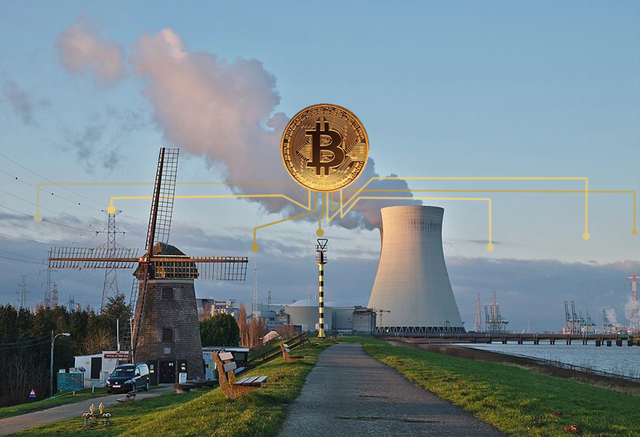Is Bitcoin Worth the 3 Gigawatts of Energy It Consumes?

Sometimes the physical nature of the digital currency Bitcoin and its impact on our ecosystem is forgotten since Bitcoin is often interrupted to be money on the internet when it’s actually the Internet of money.
A new study has estimated the energy consumed every year for mining bitcoin to be at least 2.55 Gigawatts and this number might increase to 7.7 Gigawatts of electrical power by the end of 2018 which have raised the concerns of environmentalists and subjected the bitcoin community to a lot of criticism regarding the future of its proof-of-work algorithm and whether they should switch to a more environmentally friendly way of mining.
However, a lot of these critics have missed the point of why mining exists in the first place and how important it is for an immutable, global, and censorship-resistant system of payment. The process of mining Bitcoin is (understandably) misunderstood to mean the creation of new bitcoins since the word “mining” is associated with the process of extracting scarce materials like Gold or Coal.
However, the main objective of mining is not to create new coins but to secure the Bitcoin Blockchain. For a public and decentralized ledger to hold billions or possibly trillions of dollars’ worth of value it has to have a sophisticated database that can verify and store spent and unspent transactions*. This blockchain has been running for 9 years without it being hacked or altered making it the most immutable ledger humanity has ever created.
And so, the question shouldn’t be whether or not Bitcoin is bad for the environment or it’s consuming a lot of energy, because the answer is obviously yes, but is it worth the energy it consumes? An analogous question to ask is “Do air conditioners consume a lot of energy?” And the answer is yes, but they do serve a pretty good job at keeping your office nice and cold.
Another argument for mining is that it’s geographically independent which means that people who want to invest in this technology can install their mining rigs where electricity is cheap. In this market arbitrage mining can take place anywhere on earth especially at places where the supply of electricity exceeds the demand. This method of leveraging excess energy can benefit the renewable energy market by solving the ‘negative prices’ issue created by the lack of proper distribution networks and storage systems. Mining facilities can be installed at these places helping green energy entrepreneurs to achieve a faster return on their investments. Crypto start-ups are already experimenting with this idea (i.e Envion), but let’s not get too optimistic.

A good way of measuring the ‘energy consumption worthiness’ of a new system is to compare it with other ones that serve a similar purpose. If the purpose of AC’s was to keep your office cold, why not just buy 10 fans? Well because that would leave you with a crowded office full of flying papers of course. In the case of Bitcoin, we need to compare it with the current monetary system. When you use your VISA card to buy ice cream the transaction may look smooth and instant but it’s because you’re not seeing the other side of the coin (pun not intended). The reality is that transactions are processed and validated through hundreds of thousands of data centers and servers working 24 hours to do fraud detection and money laundering prevention. Moreover, and leaving the energy cost of constructing the banking infrastructure aside, banks operate in buildings and towers that drain energy resources with all kinds of electronic appliances.
Carlos Domingo, Co-founder of SPiCE VC has calculated with very conservative numbers the power needed to run banking branches, servers, and ATM’s and the results: 58 Twh on branches, 26 Twh on servers, and 13 Twh on ATM’s for a total of close to a 100 Twh a year or 11.4 Gigawatts three or four times less efficient than the Bitcoin network.
“… assuming an average branch has 10 light bulbs, two air conditioning units that are only used 20% of the time and 12 desktop computers running an average of 12 hours a day, 20 days a month through the year.”
It is fair to note that the mining difficulty of Bitcoin is still increasing and hasn’t reached it’s peak which means that as long as mining is profitable Bitcoin’s power consumption will only increase. That’s why developers around the world who are working on the Bitcoin project are implementing a second layer protocol called The Lightening Network that would increase the efficiency and speed of Bitcoin while reducing the transaction fees by orders of magnitude allowing you to transmit payments as low as 0.01 USD cent in seconds or even milliseconds moving these micropayments to an off-chain layer that doesn’t require mining.
*Unspent Transactions or UTXOs are the outputs of spent transactions that can be used as new inputs, meaning that UTXOs Stored on this database are the coins themselves.
Useful links and videos:
Bitcoin Energy Consumption Index
Fake News: Bitcoin Energy Consumption
Bitcoin Q&A: Energy consumption
Bitcoin Q&A: The value of proof-of-work
For more energy and blockchain related news you can follow me on
Medium: https://medium.com/@basmalasi
Steemit: https://steemit.com/@basemsi
LinkedIn: https://www.linkedin.com/in/basem-alasi/
To the question in your title, my Magic 8-Ball says:
Hi! I'm a bot, and this answer was posted automatically. Check this post out for more information.
Best article on this topic (energy) by far! I upvoted of course, resteem it and follow you! Have a nice Sunday and week!!!
Thanks :)